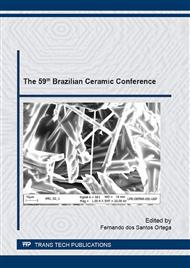p.362
p.367
p.373
p.379
p.383
p.387
p.392
p.398
p.404
Use of Sugarcane Bagasse Ashes as Raw Material in the Replacement of Fluxes for Applications on Porcelain Tile
Abstract:
This study evaluated the potential use of Sugarcane Bagasse Ashes (SBA) as a flux, replacing phyllite for the production of enamelled porcelain tile. The raw materials of the standard mass components and the SBA residue were characterized by testing by XRF, XRD, AG, DTA and TGA. Test samples were fabricated, assembled in lots of 3 units and sintered at temperatures of 1150 ° C to 1210 ° C. The results of the physical properties, mechanical properties and SEM of the sintered samples, showed that the formulation, G4 - in which applied 10% of SBA replacing phyllite, sintering temperature 1210 ° C showed better performance as the previously mentioned properties due to the formation of mullite crystals, meeting the prerequisites of standards for enamelled porcelain tile, while reducing the environmental impact and the cost of production.
Info:
Periodical:
Pages:
383-386
Citation:
Online since:
November 2016
Keywords:
Price:
Сopyright:
© 2017 Trans Tech Publications Ltd. All Rights Reserved
Share:
Citation:


